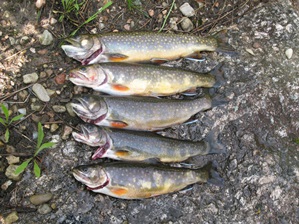
Michigan.gov
A spring brook trout catch from the Upper Peninsula. Credit: Michigan.gov
By KALEY FECH
Capital News Service
LANSING — Anglers fishing for brook trout in the Upper Peninsula this season can tackle portions of 36 streams where the daily bag limit has been increased to 10 fish.
The season just opened and runs until Sept. 30.
“It’s been an evolving issue,” said George Madison, a Baraga-based fisheries manager for the Department of Natural Resources (DNR). “For many years, the daily possession limit was 10 brook trout. After a while, there was concern from sport anglers and groups that the limit could be too much on streams that receive a lot of fishing pressure.”
In 2000, all of the state’s Type 1 trout streams changed to a five-fish bag limit, Madison said. However, some people felt there were a lot of streams that didn’t receive much fishing pressure, and the 10-fish limit could still be in effect in those areas.
Most streams in the state are Type 1.
“Several years ago we did some experimental streams with the 10-fish limit to evaluate if the people catching 10 fish would truly impact the populations or not,” Madison said. “The evaluation went on for four years, and every summer was different. We couldn’t really tell if populations were being impacted by the 10-fish limit.”
Phil Schneeberger, the Lake Superior Basin coordinator for the DNR, said brook trout populations have a high variability from year to year due to environmental factors, with or without an increase in the bag limit.
“There was some evidence of a decrease in population in some streams with an increase in the bag limit, but I wouldn’t call it compelling,” he said. “The population also decreased in some streams that did not have a increase in the bag limit. There are just so many other factors that can make the population fluctuate.”
However, Madison said the study did show that many remote streams in the U.P. get little to no fishing pressure,.
In 2016, the Natural Resources Commission decided to open more streams to the higher bag limit, he said. “All in all the decision was supported by the public. They recognized this would diversify fishing opportunities across the U.P. areas.”
All but one of the U.P.’s 15 counties has at least one stream on the list of those with a 10-fish bag limit. The sole exception is Menominee County.
“I think it’s a good opportunity for the anglers,” Madison said. “We’ve selected streams throughout the U.P. so that whatever county you’re in, you have an opportunity nearby to have a stream that would have a higher possession limit.”
One reason the DNR is increasing the limit is because it’s not seeing as many stream anglers.
“At one time, it was very popular. Years ago there would be anglers packed along the river. Nowadays, you don’t see that as much,” Madison said. “Anglers have become a little more sedentary where they like to fish out of boats for walleye or bass.“
One problem is that some anglers, especially those who are unfamiliar with an area or stream, may be confused because only a portion of some streams has the higher limit.
However, Madison said DNR maps try to make the boundaries clear-cut, such as a county road “so people would know that the waters upstream from this road are 10-fish possession limit and waters below the road are five-fish possession limit,” he said.
Another problem for the DNR is the difficulty of enforcing the regulation. For example, if a conservation officer comes across an angler near one of the boundaries with 10 fish in his or her cooler, the officer has no way of knowing on which side of the stream the angler caught the fish.
Schneeberger said,“We realize that with the proximity of some of the increased bag limit streams so close to the five-bag limit streams, it’s going to be almost impossible to enforce it rigorously.”
However, Madison said most anglers are pretty good at following the rules.
“Most of our regulations are based on an honor system. Ninety-nine percent of the anglers follow the letter of the law.”
Based on the DNR’s creel census studies, most people catch between three and five fish, Madison said. “Although there are people that fish hard and are good anglers. They know where to go and they can catch 10 fish.”
There’s a surge in fishing from the season opener through early summer, “and then it kind of wanes after that,” Madison said. “People move on to other activities. We see a little bit of an uptick in September because people get out for the fall colors.”